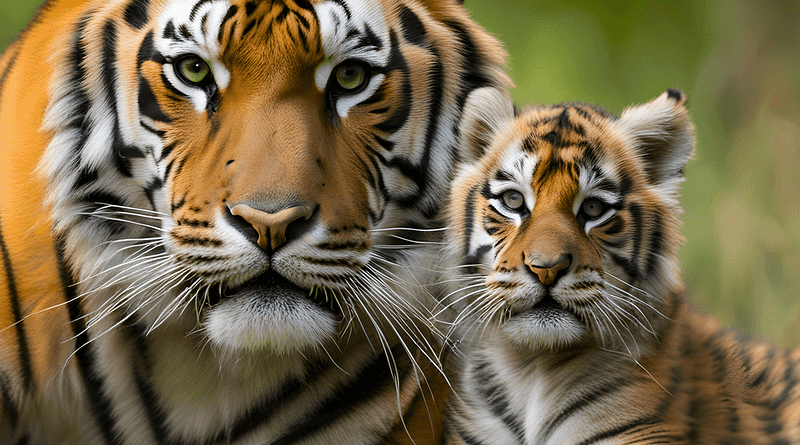Tigers as Top Predators: Their Impact on Ecosystems
 In the natural world, Tigers, the majestic big cats, play a pivotal role as top predators. This article explores their influence on ecosystems and the delicate balance of nature, highlighting the profound impact of Tigers as Top Predators. Join us in discovering how these magnificent creatures shape the world around them.
In the natural world, Tigers, the majestic big cats, play a pivotal role as top predators. This article explores their influence on ecosystems and the delicate balance of nature, highlighting the profound impact of Tigers as Top Predators. Join us in discovering how these magnificent creatures shape the world around them.
The Significance of Tigers in Ecosystems
Tigers play a unique and significant role in maintaining the health and harmony of ecosystems. Their impact is far-reaching, influencing various aspects of the environment. Tigers, as apex predators, help control prey species’ populations, preventing overgrazing and habitat degradation and protecting plant diversity. By preying on herbivores, tigers indirectly safeguard plant species, supporting a diverse range of organisms within an ecosystem. Their territorial behavior can shape landscapes, helping preserve habitats for countless species.
Ecological Disruption in Their Absence
The absence of tigers can lead to imbalances within ecosystems, impacting flora and fauna. Prey populations can explode in regions where tigers have disappeared, leading to overgrazing, habitat degradation, and the loss of plant diversity. Tigers are part of a predation chain that keeps ecosystems in check. Their absence can disrupt this chain, causing unforeseen consequences.
The Global Impact of Tiger Conservation
The conservation of tigers is not just about protecting a single species. It has far-reaching effects on global ecosystems. Preserving forests where tigers reside helps mitigate climate change by storing carbon and maintaining the balance of greenhouse gases. Tigers are considered keystone species, meaning their presence or absence significantly impacts the structure and function of ecosystems.
Tigers and Prey Populations
Tigers regulate prey populations through their hunting activities. By controlling the numbers of herbivores like deer, tigers prevent overgrazing. Overgrazing can lead to habitat degradation and a loss of plant diversity, affecting not only the vegetation but also the creatures that depend on it.
Preserving Biodiversity
By preying on herbivores, tigers indirectly safeguard plant species. When herbivore populations are controlled, plant diversity thrives. Diverse plant life supports a wide range of organisms, from insects to birds, contributing to the overall health of the ecosystem.
Shaping Landscapes
Tigers’ territorial behavior can shape landscapes. Their presence helps preserve habitats for countless species. These protected areas not only benefit tigers but also provide essential refuges for a variety of plants and animals.
Ecological Disruption in Their Absence
The absence of tigers can have severe consequences for ecosystems. Without top predators, prey populations can surge. Overgrazing becomes a threat, leading to habitat degradation and a loss of plant diversity. The entire food web can be disrupted as the predation chain breaks down.
The Global Impact of Tiger Conservation
The conservation of tigers is not just about protecting a single species. It has far-reaching effects on global ecosystems. Preserving forests where tigers reside helps mitigate climate change by storing carbon and maintaining the balance of greenhouse gases. Tigers are considered keystone species, meaning their presence or absence significantly impacts the structure and function of ecosystems.
FAQs About Tigers and Ecosystems
-
How do tigers affect prey populations?
Tigers regulate prey populations by controlling their numbers, preventing overgrazing and habitat degradation, and protecting plant diversity.
-
Are tigers essential for ecosystem balance?
Yes, tigers are crucial for maintaining ecological balance by preventing prey population surges, preserving plant diversity, and shaping landscapes.
-
How do tigers contribute to climate change mitigation?
Tigers help mitigate climate change by preserving the forests in which they reside. These forests store carbon, reducing greenhouse gas emissions.
-
What is a keystone species, and why are tigers considered one?
A keystone species has a disproportionately large impact on its environment. Tigers are considered keystone species due to their vital roles in controlling prey populations and preserving biodiversity.
-
What happens when tigers are absent from an ecosystem?
In the absence of tigers, prey populations can surge, leading to overgrazing, habitat degradation, and disruption of the predation chain.
Conclusion
In conclusion, tigers as top predators are not just charismatic symbols of the wild. They are ecological linchpins, playing a pivotal role in maintaining the health and balance of ecosystems. As we continue to witness their magnificence in the wild, let us also recognize the importance of conserving these remarkable creatures for the well-being of our planet.









